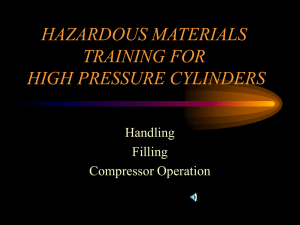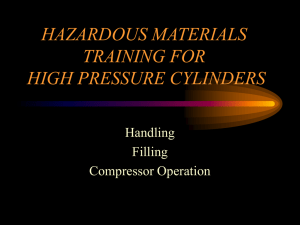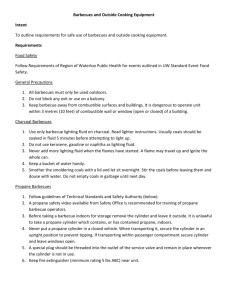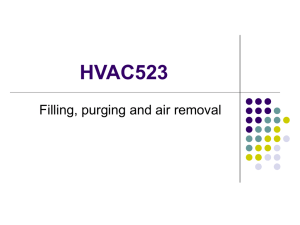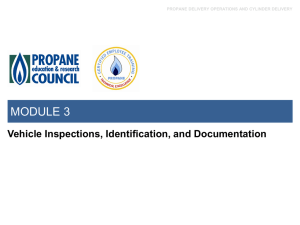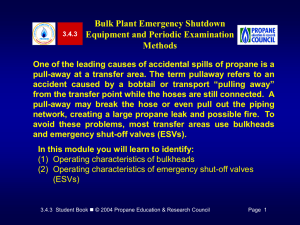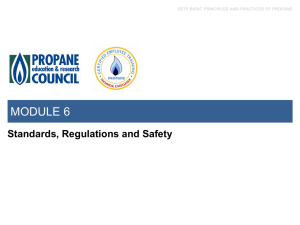3.3.4 CETP Instructor PowerPoint Template
advertisement
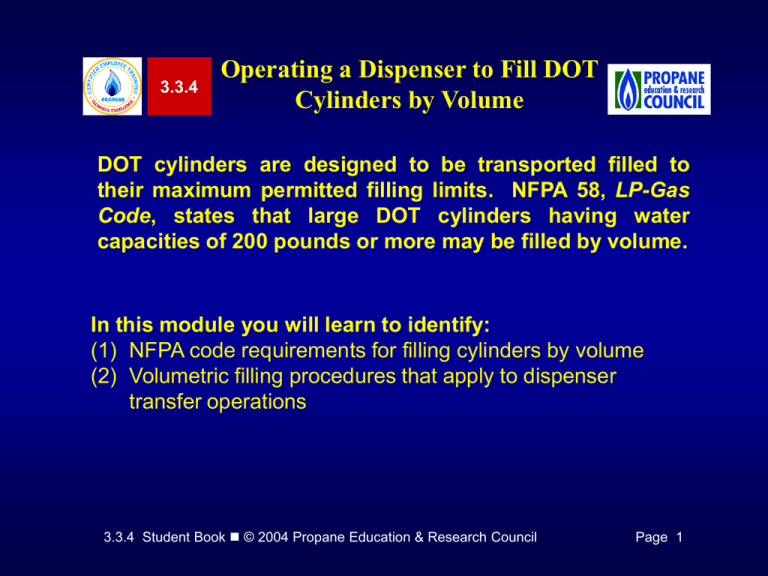
3.3.4 Operating a Dispenser to Fill DOT Cylinders by Volume DOT cylinders are designed to be transported filled to their maximum permitted filling limits. NFPA 58, LP-Gas Code, states that large DOT cylinders having water capacities of 200 pounds or more may be filled by volume. In this module you will learn to identify: (1) NFPA code requirements for filling cylinders by volume (2) Volumetric filling procedures that apply to dispenser transfer operations 3.3.4 Student Book © 2004 Propane Education & Research Council Page 1 NFPA Code Requirements for Volumetric Filling NFPA 58 2001 4.4.3.2 The volumetric method shall be limited to the following containers, where they are designed and equipped for filling by volume: (1) Cylinders of less than 200-lb water capacity that are not subject to DOT jurisdiction (2) Cylinders of 200-lb water capacity or more NFPA 58 7.4.3.1 (1) & (2) 2004 3.3.4 Student Book © 2004 Propane Education & Research Council Page 1 NFPA Code Requirements for Volumetric Filling Three points should be understood concerning 4.4.3.2: 1. DOT cylinders must have properly operating fixed maximum liquid level gauges and correct length dip tubes before they can be filled by volume. 2. Provision (1) of 4.4.3.2 means that DOT cylinders of less than 200 pounds water capacity transported in commerce (subject to DOT jurisdiction) must be filled by weight. (See footnote) A DOT motor fuel cylinder used on forklift operated only within the bulk plant can be filled by volume, because it will not be transported in commerce. Similarly, motor fuel cylinders filled at a dispenser at commercial customer locations may be filled by volume, if the cylinders are not transported off-site. 3.3.4 Student Book © 2004 Propane Education & Research Council Page 1 NFPA Code Requirements for Volumetric Filling Three points should be understood concerning 4.4.3.2: 3. Provision (2) of 4.4.3.2 means that large cylinders (in excess of 200 pounds) designed for stationary installation may be filled by volume at any location. Figure 1. Stationary DOT Cylinder 3.3.4 Student Book © 2004 Propane Education & Research Council Page 2 Procedures for Volumetric Filling Step 1: Complete an external visual inspection of the cylinder. If any defect is found that requires the cylinder to be condemned, removed from service, or if the cylinder requalification marking is not current—stop and do not continue the filling operation. Step 2: Open the liquid outlet valve on the dispenser storage tank and the valve in the by-pass return line. Step 3: Open the vent valve on the fixed maximum liquid level gauge. If liquid (steady white mist or fog) appears and continues to vent after a few seconds—stop and do not continue the filling operation—the cylinder is already filled. If no liquid appears, or immediately disappears after initial venting, continue the filling operation. 3.3.4 Student Book © 2004 Propane Education & Research Council Pages 2 & 3 Procedures for Volumetric Filling Step 4: Using the required adapter, connect the transfer hose to the cylinder fill valve or service valve outlet or coupling. Step 5: Start the pump. Step 6: Open the valve slowly on the end of the hose. Step 7: If applicable, open the service valve slowly on the cylinder. Step 8: When a steady white mist fog is first emitted from the gauge vent valve, this indicates the maximum permissible fill level has been reached. Immediately close the hose end valve. Step 9: Close the fixed maximum liquid level gauge. 3.3.4 Student Book © 2004 Propane Education & Research Council Pages 2 & 3 Procedures for Volumetric Filling Step 10: Shut off the pump. Step 11: Close the cylinder service valve, if applicable. Step 12: Partially disconnect the filling adapter (approximately ¼ turn) until all trapped liquid is vented. If liquid venting through a fill valve does not stop within seconds, retighten and seal the filling adapter. Allow a few seconds for the vented propane to disperse. Use a rubber or plastic mallet to strike the filler valve to re-seat its back checks, then partially disconnect again to vent the trapped propane. Step 13: After the trapped propane has vented, disconnect the transfer hose and secure it in its holder or stowed position. 3.3.4 Student Book © 2004 Propane Education & Research Council Page 3 Procedures for Volumetric Filling Step 14: Check the cylinder and its valves for leaks. Check to ensure the cylinder is not overfilled. Step 15: Apply DOT labels or a cylinder warning label if the original manufacturer’s label is not legible. 3.3.4 Student Book © 2004 Propane Education & Research Council Page 3 Time to See If You Got the Key Points of This Module… • Complete the Review on page 4. • See if you are ready for the Certification Exam by checking off the performance criteria on page 5. 3.3.4 Student Book © 2004 Propane Education & Research Council Pages 4 & 5

